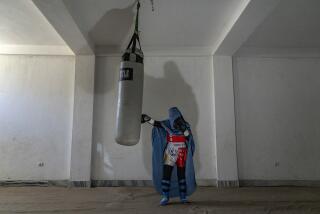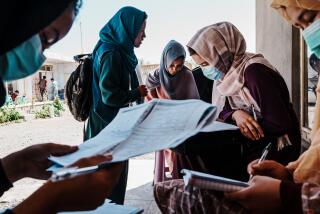Sudden Hope for Taliban’s Foes
- Share via
BAGRAM, Afghanistan — On the front line in Afghanistan’s draining civil war, 22 miles from the capital, Kabul, slight, silent boys armed with Kalashnikovs stare across a pockmarked village of deserted mud houses at the Taliban positions.
The Afghan opposition, having suffered defeat after defeat at the hands of the Taliban, is suddenly fired with hope. Their savior, they believe, will be America.
With the Taliban government that took over Afghanistan five years ago emerging as a key target in President Bush’s battle against terrorism, the opposition fighters of the Northern Alliance are hoping the United States can bring down the enemy they failed to defeat.
The deputy commander at the Bagram military air base, Col. Malang, who like many Afghans goes by one name, acknowledged that there is no chance of defeating the Taliban and taking the capital--unless Washington helps.
“We can go on fighting for a long time, but America must destroy the terrorists,” he said. “If the Americans want to destroy them, we are ready to go to Kabul.”
With Afghanistan singled out as a target for offering shelter to Osama bin Laden, the man accused by U.S. officials of masterminding the terrorist attacks on New York and the Pentagon, the world’s attention has suddenly turned to the ragged Afghan fighters who have been at war with the Taliban movement since it emerged in 1994.
In the front-line dugouts, a young opposition soldier stands dwarfed by his huge antitank gun. The ground is strewn with shells from a Soviet antiaircraft gun. The dugout has changed hands repeatedly as the Taliban has sought to push the Northern Alliance back toward the Panjshir Valley.
Grieving for Lost Leader
The opposition stronghold in the northern Panjshir Valley is torn between grief and elation. Black flags fly on buildings and cars all across the valley, in mourning for Northern Alliance leader Ahmed Shah Masoud, the legendary “Lion of the Panjshir” who was mortally wounded in a suicide bombing two weeks ago by men posing as journalists. Nearly every window bears his portrait.
His death was a devastating blow to the opposition forces. Yet there is an air of jubilant expectation that the Northern Alliance will soon have an opportunity to avenge his murder, which most here blame on the Taliban.
So optimistic is the atmosphere that the sight of foreigners driving through has small dusty boys dashing into the road shouting “Amrika!”
The helicopter that labors, shuddering, over the majestic, stony peaks of Afghanistan, more than 14,000 feet high, gives a good indication of the state of much of the Northern Alliance hardware. It’s a museum piece, patched roughly with fiberglass.
The descent into the Panjshir Valley opens up an ancient world. The dust rises gently as villagers shepherd a group of camels. Turbaned men ride donkeys or Russian-made motorcycles.
Cuboid mud houses squat in villages with no running water and no electricity. A small girl of perhaps 5 carries four heavy canisters of water, slung on a pole across her shoulders, then sinks into the dust under the burden.
Women in pale blue chadri--garments to shroud their faces and bodies--scuttle about the streets, children in their arms, turning away when cars pass.
The poverty and deprivation is most striking in the refugee camps, where people who fled the Taliban’s advance have been stranded, often for three or more years--long enough to have dug their tents into the ground and built low stone fences around them.
The country is littered with the twisted junk of successive wars. Every hundred or so yards along the Panjshir River sit the hulks of rusty tanks from the 1979-89 war with the Soviet Union, which, aided by the United States, the Afghan fighters won.
With the Taliban under pressure amid talk of an American attack on Afghanistan, the Northern Alliance has in recent days stepped up attacks. Abdullah, foreign minister of the ousted government of President Burhanuddin Rabbani, said at a news conference in the town of Jabul os Saraj on Sunday that alliance forces had made solid advances, a claim that could not be independently confirmed.
There has been no such attack from Bagram, but the Northern Alliance commander at the military air base here, Hawani, 27, said his men are ready.
“It’s a good time to attack the Taliban now. If we get the order, we’ll storm Kabul,” said the former shoemaker.
“We need Kabul--now. We want to be in Kabul now,” he said.
But despite his brash words, on Sunday there was no sign of mobilization for an offensive. The mountains sputtered with sporadic shell explosions, heating up as evening drew near. Even so, in this area the war seemed to be unfolding at a lazy pace.
Warriors like Col. Malang wear the experience of many years of war like a mantle of honor in a country where fighting is the main occupation.
His face is sun-ravaged, his hair graying. He breaks readily into a smile of welcome for foreign visitors. Like his men, he wears a long, plain cotton tunic, with cotton trousers, topped with a dark vest. He carries a radio that crackles constantly.
He says the Northern Alliance has about 2,000 men in the front-line area near Bagram air base, built by the Soviets in the early 1980s.
But the Taliban controls a village just 500 yards away and holds strong positions in the surrounding hills, making it impossible to use the landing strips. A rocket protruding like a metallic flower beside one of the airstrips underscores the Taliban’s unsuccessful efforts to knock out the control tower, which was long ago gutted of equipment.
High mud walls run along each side of the dusty road to the airport, wending maze-like, a canopy of beech trees overhead. So deep are the ruts in the road that they knock out the muffler on an ancient Russian Volga car, but the driver merely shrugs, pulls off the exhaust pipe and throws it into the trunk.
If the Taliban could be dislodged from the surrounding mountains, the airport could be a strategic military post, given its proximity to Kabul. It has long airstrips, once used for large Soviet cargo craft, but now overgrown and shabby.
Malang, who retreated from Kabul when the Taliban took charge in 1996, said his men would welcome American planes on the runways here.
“When the Russians came here people didn’t like it because they did not let the local people live in peace. But now people are tired, after 22 years of war,” he said, referring to the various conflicts that have ravaged this desperate country since the Soviet invasion in 1979.
“We are hoping the Americans can bring peace. We are hoping the Americans can help us, with our army, to destroy the terrorists. All the people around here think this,” he said.
Decades of War Leave Harsh Landscape
War has so tattered Afghanistan that it is difficult to conceive how the place might look if another one rages across the territory.
Millions of people have fled their homes. The country has been stricken by drought, which has international relief agencies warning of a humanitarian catastrophe, particularly if thousands more people are displaced by war.
The Northern Alliance is a motley collection of former Communists, anti-Communists and moderate Muslims, whose numbers range from 15,000 to 30,000, depending on who is counting. It gets assistance from countries like Russia and Iran, and controls about 5% of the country.
The Taliban, made up mostly of ethnic Pushtuns who have imposed a strict form of Islamic rule on the country, is believed to have about 50,000 fighters, as well as foreign assistance that makes it impossible to defeat, Malang said. Pakistan has supported the Taliban but denies offering military assistance.
Malang and other Northern Alliance fighters were wary of what might happen should American military intervention succeed in deposing the Taliban.
Having lived through 10 years of Soviet occupation, many are concerned about whether a U.S. ground force might move in, oust the Taliban, but fail to quickly depart.
Without being specific, Malang said the Northern Alliance would be supportive if the Americans installed a “good” government. But asked how he would feel if American forces occupied the country for a prolonged period, he and others answered vaguely.
“We just want the Americans to destroy the terrorists” was all he would say.
Abdul Kadir, 37, who commands 250 fighters in the Panjshir Valley, said his men would be glad if America ousted the Taliban, “but we don’t want some group from America to bother us.”
Avzali, a 28-year-old fighter speaking in broken English, said he would welcome American soldiers--if they worked together with the Northern Alliance.
“But they should go back after the victory on the Taliban and Osama bin Laden because we fought Russian soldiers, Pakistani soldiers and terrorists. We want to be a free Afghanistan. We don’t want other soldiers to stay in our country.”
Special correspondent Sergei L. Loiko contributed to this story.
More to Read
Sign up for Essential California
The most important California stories and recommendations in your inbox every morning.
You may occasionally receive promotional content from the Los Angeles Times.













